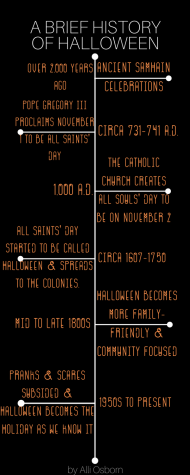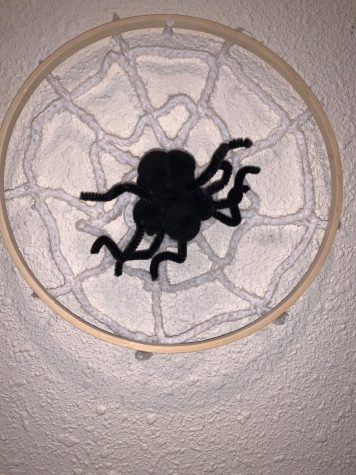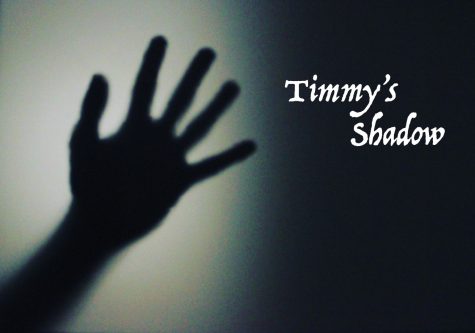The History of Halloween

Halloween is many people’s favorite holiday, what with all of the excitement and spookiness swirling around in the cool October air. From haunted houses to history to seemingly everlasting candy, there is something for everyone in this centuries-old holiday. Many people don’t consider the rich history behind Halloween; I know I sure didn’t. I first learned about Halloween‘s history several years ago outside of school, and I wondered why it had never been taught about in school. After all, it is a relatively important holiday, most kids love Halloween, and there is a cool story that behind it that is interesting to learn about. Anyway, Halloween stems from ancient Celtic traditions, religious rivalries, and tortuous children, making it one of the most intriguing times of year.
The first known beginnings of Halloween start with the ancient Celtic holiday Samhain, pronounced sow-in, over 2,000 years ago. Samhain was basically the start of the Celtic new year, celebrating the end of the harvest season and the start of winter, or the darker half of the year. Supposedly, the veil between the living world and the dead or spirit world was blurred during this time of year, so it is said that the ghosts of the dead would return to the living for a time. During Samhain, people lit sacred bonfires to burn offerings, like crops and animals, for the Celtic deities and would dress in costumes of sorts to ward off evil spirits and attempt to tell each other their fortunes. It is believed by the Celts that the presence of these spirits, good or bad, helped priests make predictions about the future, providing people with a sense of comfort for the coming winter. By 43 A.D., the Romans had conquered most of the Celtic territory, merging their traditions with those of the Celts. The October holidays of Feralia, a day that commemorated the passing of the dead and a day to honor Pamona, the Roman goddess of fruit and trees, with Samhain, setting the precedent for future developments of this holiday.
On May 13, 609 A.D., Pope Boniface IV established the Catholic feast of All Martyrs Day to honor all Christian martyrs, which was later expanded on by Pope Gregory III to include all saints as well. It was in 1,000 A.D. that All Souls’ Day was created, which was a day to honor the dead, celebrated on November 2. While All Souls’ Day was similar in its customs to Samhain, the day was created to demolish the pagan holiday of Samhain, as Christianity was spreading across Celtic lands. All Saints’ Day was also referred to as All-hallows or All-hallowmas and the day of Samhain began to be called All-Hallows Eve, and eventually Halloween.
As the British colonies were established, the traditions of the people traveled to the New World with them, resulting in Halloween moving to America. New England was largely protestant, so the celebration of Halloween was limited. It was much more commonly celebrated in Maryland and the southern colonies. Over time, the traditions of the colonists and the Native Americans combined to create a newer version of Halloween like the one we celebrate today. This Americanized version of Halloween was very much like Samhain, as people would share stories of the dead, tell each other’s fortunes and dance and sing. As time went on and more people began to celebrate Halloween, they adopted more European traditions, like dressing up in costumes and going to houses to ask for food and money, which was an early form of what we know as “trick-or-treating” today. In the 1800s, people pushed for the holiday focus to turn to community and neighborly get-togethers rather than stay on spirits, scares and witchcraft. Because of this, parents were encouraged to take away and/or reprimand “grotesque” or “frightening” things that children had or participated in. Despite their efforts to contain their children and make Halloween have a more pleasant overtone, parents found that their children had turned to trickery and vandalism to have fun on the holiday. This was especially present during the 1920s and 1930s, which left many civilians in fear of these somewhat demonic children around the time of Halloween. The pranks and threats were brought to an end in the 1950s as Halloween became more focused towards children and the once city-wide parties were moved to classrooms and homes, as to keep them under control.
Halloween has come a long way to get to where it is today, and it resulted in great rewards. Many old traditions and practices are still present during the holiday to this day, and as time has passed, more traditions and customs have been added to the Halloween celebration. Halloween is now the second largest commercial holiday, after Christmas, with people spending about $6 billion annually. The holiday has lasted a very long time, and it will certainly last much longer.

Allison Osborn is a sophomore at Ada High School. This is her first year as a staff member of The Cougar Call. She is looking forward to informing and...





